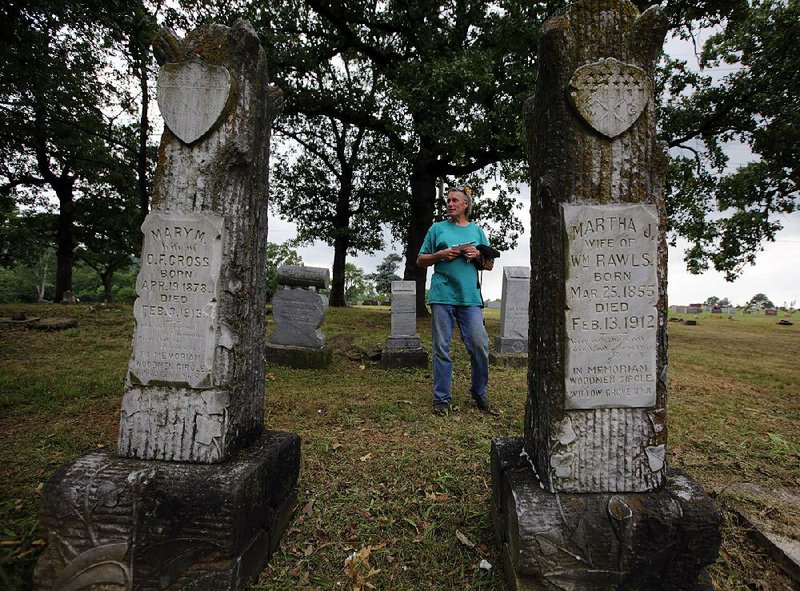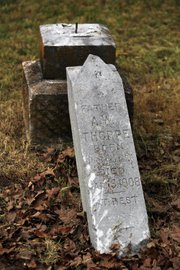Walking through the long-neglected, 1880 Thomas Cemetery in North Little Rock's Levy area, Kristal Clark gestured toward an area that lacked any grave markers, despite the hundreds of dead interred there.
"The graves go all the way to the property line," Clark said last week. "You just can't see them."
Clark can recite plenty of colorful lore about the lives and grisly deaths of so many of those buried in Thomas Cemetery, 2 acres of private property tucked away off Division Street next to the 60-acre, perpetual care Edgewood Cemetery where Clark works as grounds supervisor.
What Clark wants is for others to know Thomas Cemetery's history as well. As a North Little Rock History Commission member, Clark is helping lead the commission's work in seeking the city's help to preserve what's left of the cemetery and to embrace its history.
Thomas Cemetery is filled mainly with members of North Little Rock's working class and their children, along with more than 30 Civil War veterans. Many of the 600 or so graves are from the late 1800s and early 1900s, Clark said.
Aided by research during the spring semester by a senior-level Arkansas history class from the University of Central Arkansas in Conway, Clark and the History Commission are exploring ways to restore the cemetery grounds, even though there are other obstacles besides deteriorating headstones and the lack of proper care of the grounds.
There isn't a known owner with clear title to the cemetery, Clark said. The grounds are vandalized from time to time, including the toppling of large headstones and an attempted burning of the U.S. flag in just the past few days, she said. Thomas Cemetery has had a stigma of being mistaken for a "pauper's graveyard," which could have have added to its long neglect, she said.
J.W.B. Thomas, who founded the cemetery in 1880, according to the year on the arched entryway, didn't want grieving families to have to pay for burials, Clark said. Young children make up the vast majority of those buried there, she said, many of whom died from malaria or typhoid fever. There are also several murder victims and a number of people who took their own lives, she said, citing research of identifiable graves.
Thomas, a native Tennessean who moved to Arkansas in 1867, according to his tombstone, died in 1885. His wife filed a quitclaim deed in 1893 to deed the property to three families, who have long been disconnected from the cemetery, History Commission Executive Director Sandra Taylor-Smith said. Without clear ownership, any true restoration work can't occur on the private property.
"We can't form a nonprofit or do much of anything with it unless there is an acknowledgment from the owner," Taylor-Smith said. "We've been trying to run the deeds. It's critical to find out if there is an owner anywhere. That's what we're trying to determine. So far, no luck."
Clark said she has located a few descendents of one of those families, but they didn't want to get involved.
Clark's own involvement comes from working the past nine years at Edgewood Cemetery, founded in 1923. When her workday was over, she said, instead of driving home to Vilonia during peak-afternoon traffic, she began spending time at Thomas Cemetery. Soon she started picking up litter, cleaning headstones and gaining an interest in the cemetery and who was buried there, she said. She moved to North Little Rock about four years ago.
"Kristal is just a force of nature," said Story Matkin-Rawn, an assistant history professor at UCA who taught the Arkansas history course that took on Thomas Cemetery as a semester project. "She brought all these files and was telling all these stories. As a historian, I got really excited."
Matkin-Rawn had learned about Thomas Cemetery through her contacts with the Arkansas Historic Preservation Society, she said. For its uniqueness and time period, she said she considers the cemetery "an extremely valuable property" historically as an early "working class" cemetery.
"These are not highfalutin people there," Matkin-Rawn said. "What I think is good about the cemetery is that these were people who are not considered to be at the top of the social world, and their lives are really interesting.
"There is such neat evidence of how everyday people lived their lives," she added. "The past is not always about a president giving a speech."
The label of pauper's cemetery, Matkin-Rawn said, came about because of the cemetery's reputation for free burials.
"That's been turned into a stigma to the loved ones buried there," she said. "It was a beautiful cemetery back then and they could put that money toward the tombstone or the casket or something else."
The ways of some lives -- and deaths -- of those buried in Thomas Cemetery weren't ordinary by today's standards, Clark said.
"I had a lady call me from Pine Bluff and say her great-grandmother is buried out there and she was 'just an old whore.' I was shocked," Clark said. "I had found [the woman] listed as a seamstress in the census. The lady who called me said a lot of 'working girls' were buried there. [Seamstress] is what they would put down [as occupation] on the census."
Thomas Cemetery reflects an important period in the history of North Little Rock, and its time as Argenta, formed as a rough railroad town near the turn of the century, Matkin-Rawn said.
"To me, that's great," Matkin-Rawn said of the "seamstress" story. "North Little Rock was essentially a wild frontier town. Through Thomas, you can see how violent Arkansas' past was, too. There were a lot of murders and a lot of domestic-violence victims."
Among the murder victims buried at Thomas Cemetery was a mother whose second husband, a railroad worker, "came home drunk and put a double-barrel shotgun to her face and pulled the trigger," Clark recalled.
"Her murder was said to be the most gruesome, goriest of the time period," she said.
Another married woman was killed in an ax attack on her and her husband, who survived, Clark said. Both were German immigrants, she said.
Many others, especially very young children, died from disease, she said. Of the adults, there are "quite a bit of suicides here," she added.
"On this side of the [Arkansas] river, conditions were swampy," Clark said of the early 20th century. "There were lots of typhoid fever, malaria and pneumonia."
While Clark has found out much about the cemetery's history, she said she will continue to try to locate its true owners and do as much at the cemetery as she legally is allowed.
"I don't actually have written permission to be on this property," Clark said. "Without that permission, your hands are tied."
She can, however, keep trying to discover more about the lives and deaths of those interred at Thomas Cemetery.
"When I started researching I had a list of 302 names," Clark said of those in graves. "I'm up to almost 550 and I'm still adding."
Metro on 05/29/2016


